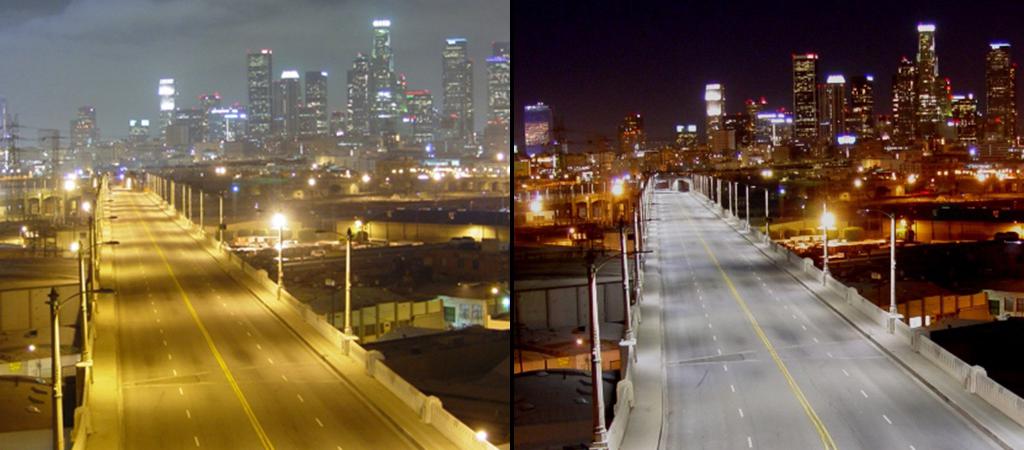
In the decades since 1970s, low and high pressure sodium lights (LPS & HPS) have become the choice of most lighting users due to their high energy efficiency, long service life and cheap price, illuminating countless city streets, buildings and homes. However, with the emergence and rapid development of LED lighting technology, more and more cities have replaced old low and high pressure sodium lamps with LED Lights, such as LED street lights, on a large scale. So, do you wonder which is better between LED street lights and LPS & HPS lamps? Here is a detailed analysis and comparison.
Table of Contents [hide]
1.4 What Are the Benefits of Low Pressure Sodium (LPS) and High Pressure Sodium (HPS) Lights?
1.5 What are the Main shortage of Low Pressure Sodium (LPS) and High Pressure Sodium (HPS) Lights?
1.6 What's the main applications of Low (LPS) and High Pressure Sodium (HPS) Lights?
The high pressure sodium vapor (HPS) light is a particular kind of gas-discharge light, which is comparable to LPS light (also known as a high intensity discharge, HID or arc light). The operating pressure inside the lamp is the main distinction between low and high pressure sodium lights. High pressure sodium vapor lights work at a higher internal pressure, as the name suggests. The sodium metal, which is mixed with additional elements like mercury to balance the yellow glow with some white to light blue emissions, is used to make the aluminum oxide arc tube.
The low pressure sodium vapor (LPS) light, also known as a high intensity discharge, HID or arc light, is one particular kind of gas-discharge light. The main component of the lightbulb is solid sodium metal, which is housed in a tube made of borosilicate glass and vaporizes when the lamp is turned on. The lamp starts off with a faint reddish or pink glow because the sodium is still solid. The emissions take on the distinctive bright yellow color of sodium vapor lamps once the metal has evaporated. LPS lights are usually applied in outdoor lightings, such as parking lot lighting, bridge underpass lighting. Insects are not attracted to the bright yellow tint, but it warps colors.
Both low-pressure and high-pressure sodium lights need to be ignited, which is commonly accomplished by a voltage pulse or a third electrode (an extra metal component) located inside the lightbulb. With small tubes, starting is very straightforward, but with larger lights, significant voltage may be needed. The internal gas in sodium vapor lighting often needs to evaporate into plasma during a "warm-up" period. A ballast balances the additional voltage that the light needs to operate as it heats up (a magnetic or electric device designed to provide the light constant current). More voltage is needed to create the same quantity of light as sodium vapor lights deteriorate, and eventually, when the voltage surpasses the fixed resistance provided by the ballast, the light stops working (fails). Because it takes more and more voltage to create the same amount of lumens as the light fades, lights lose efficiency with time. Nevertheless, even at their typical end-of-life, HPS lights in particular maintain a respectable light output (about 80%). (24,000 operating hours).
Since the 1930s, when sodium vapor lighting first entered commercial production, it has been used to produce lighting across large areas with a high level of efficiency. Since the human eye is particularly sensitive in the range where sodium lights work, less power is needed to produce the same level of illumination. Because of this, they are incredibly effective. Low pressure sodium lamps will also relight right away in the event of a power outage despite their lengthy warm-up time (5 to 10 minutes). When it comes to outdoor lighting, where energy efficiency is crucial, it is very helpful (such as with municipalities lighting the streets or other common areas like parking lots.) In comparison to most high intensity discharge lamps, many fluorescent bulbs, and incandescent bulbs, LPS and HPS lights are far more efficient and have a longer lifespan. They have only lately been routinely outperformed in terms of energy efficiency and lifespan with the introduction of widely available, inexpensive LED lighting.
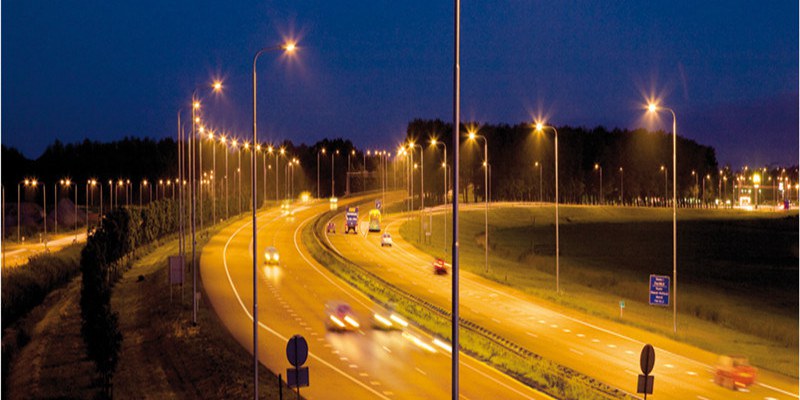
High Pressure Sodium Street Light
Sodium vapor lights have the market's weakest color rendering . Particularly LPS lights are monochromatic, which causes the items they illuminate to look shadows black as opposed to the color you would see in daylight. Although HPS lamps are superior, almost every other light on the market still outperforms them.
Sodium vapor lights need a warm up period after turned on. When the arc ignites, internal metal salts (sodium) in the gadget melt and evaporate. Only until the salts have completely evaporated into plasma does the light reach its peak intensity (which can sometimes take up to 10 minutes). The light will first seem reddish/pink when it is struck (turned on), then when it approaches its typical operating temperature, it will change to its distinctive yellow color.
There is a minor quantity of hazardous mercury in high pressure sodium lights. At the end of the bulbs' useful lives, the dangerous mercury inside the bulbs may cause problems with trash disposal. Broken bulbs emit some poisonous mercury as a gas, but the majority of it is still inside the glass.
The light of sodium vapor lights are omnidirectional. 360 degrees of light are produced using omnidirectional lighting. Because at least half of the light must be reflected and redirected to the intended area of illumination, this technique is significantly inefficient. Due to losses caused by the necessity for light reflection and redirection, the output of omnidirectional lighting is significantly less efficient than it would be for the same light if it were directional by nature. It also means that in order to reflect or concentrate the light produced by the bulb, more auxiliary components are needed in the light fixture itself (thus increasing unit costs).
The sodium vapor lights are frequently applied to for tunnel illumination, parking lots, and street lighting, where color rendering isn't a big concern. It is also usually used in outdoor settings for institutions like schools, significant commercial structures like hospitals, or local governments managing city lights on a tight budget.
LED is short for Light-emitting diode. An electrical diode is a component or device that conducts electricity via two electrodes (an anode and a cathode), often in only one direction (in through the anode and out through the cathode). Typically, semi-conductive materials like silicon or selenium, solid state elements that conduct electricity under some conditions but not others, are used to create diodes (e.g. at certain voltages, current levels, or light intensities). The semiconductor material in the device emits visible light when current flows through it. It is a photovoltaic cell's complete opposite (a device that converts visible light into electrical current).
The LED street light or road light is an integrated light-emitting diode (LED) light fixture that is used for street lighting. LED street lights are usually designed to be suitable to be mounted on light poles. Diversified lenses provide LED street lights with different light distributions for different types of streets and roads. LED street lights could also be applied to LED parking lot lighting, garden lighting, square lighting, playground lighting, and so on.
LED Street Light Project In Malaysia
Compared to all other lighting technologies, LEDs have a very long lifespan. New LEDs have a lifespan of at least 100,000 to 150,000 hours. So the lifespan of LED street lights is also very long. Comparatively, the lifespan of a fluorescent light bulb is, at best, 10%–25% shorter (roughly 10,000 hours).
In comparison to every other commercially available lighting technology, LEDs are incredibly energy efficient. This is due to a number of factors, including the fact that they emit light in a specific direction and lose very little energy as infrared radiation (compared to most conventional lights, even fluorescent lights) (over 180 degrees versus 360 degrees which means there are far fewer losses from the need to redirect or reflect light). With LED chips of high efficacy, LED street lights also have a high efficacy of 130-170lm/W, which is much higher than the efficacy of LPS and HPS.
Easy to maintain, with lower maintenance costs and fewer hassle.
The light quality of LED Street Lights is very high, much higher than sodium vapor lights and fluorescent lights.
LED street lights need a lot less accessory lamp parts.
Without using the conventional color filters needed by conventional lighting solutions, LED Street Lights are capable of producing the whole visible light spectrum.
The light of LED street lights is directional (they emit light for 180 degrees by default). What's more, LED street lights have different lenes to get various light distributions suitable for multiple applications. This could not only make better use of light output, but also avoid light pollution.
LED street lights have faster switching time, no need a period of warm up or cool down.
You might think that the benefits of LED street lights are a no-brainer when you consider it. Despite the fact that this is more and more the case, choosing LED lighting solutions still requires some tradeoffs:
The LED street lights prices are comparatively higher. An LED lighting solution often has higher upfront expenses than the majority of the alternatives. The main drawback that needs to be taken into account is by far this. However, from a long-term perspective, LED street lights are still the right choice. On the one hand, although the initial investment is large, LED street lights have higher luminous efficiency, more energy saving, and longer lifespan. Generally, the initial investment can be saved back from the electricity bill within 3 to 5 years. As LED street lights are used more and more widely, and the production volume is increasing, the price of LED street lamps has also been falling. With the improvement of LED technology, the light efficiency of LED street lamps is getting higher and higher. In the future, it may only take less than a year to earn back the investment in replacing old traditional lamps with LED lights from the saved electricity bills. On the other hand, there are LED street lights with different prices for customers with different needs. For example, ZGSM has launched economical LED street lamps, cost-effective LED street lamps, high-end LED street lamps and so on. We also support OEM and ODM according to customer requirements. If you have any demands or questions, please check our products page or contact us for more information.
Video Of ZGSM Rifle LED Street Light
![]() Installation Manual_StreetLight_Rifle.pdf
Installation Manual_StreetLight_Rifle.pdf
![]() Data Sheet_StreetLight_Rifle.pdf
Data Sheet_StreetLight_Rifle.pdf
These two technologies use completely different approaches to produce light. While LEDs are a solid state technology, sodium vapor bulbs contain metals that are vaporized into inert gas inside the glass shell. Each technology is really effective. The distinction is that LEDs are the present day counterpart to sodium vapor lamps, which were the most effective technology in the 1970s. Although LEDs outperform sodium vapor lighting in terms of energy efficiency (which is why so many communities choose to use it to light their streets), sodium vapor lighting still falls short. Both LEDs and sodium vapor lights produce electromagnetic radiation that spans a tiny fraction of the visible light spectrum, however LEDs consume significantly less energy than sodium vapor lights do and offer the user a far greater selection of high-color rendering possibilities (thus eliminating the monochromatic black appearance of objects illuminated by LPS and HPS bulbs).
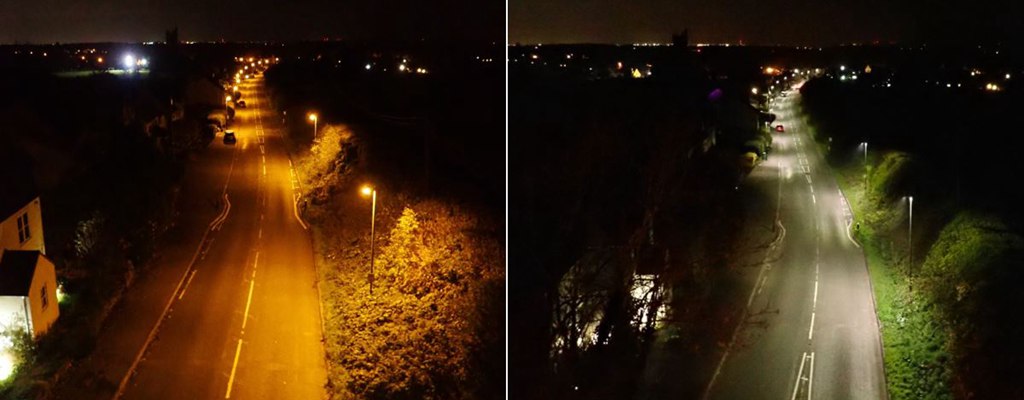
Comparison: LED Street Lights vs LPS & HPS Street Lights
(Light Emitting Diode (LED) Lights vs High Pressure Sodium(HPS)/Low Pressure Sodium(LPS) Lights)
LED Street Lights vs LPS/HPS Lights (✓=Winner, x=Loser) | ||
Item | LED Street Lights | LPS/HPS Lights |
| Correlated Color Temperature (CCT) | ✓ | ✓ |
| Color Rendering Index (CRI) | ✓ | × |
| Cycle (On/Off) | ✓ | × |
| Dimming Functions | ✓ | × |
| Light Directionality | ✓ | × |
| Luminous Efficiency | ✓ | × |
| Luminous Efficiency Maintenance | ✓ | × |
| Light Emissions | ✓ | × |
| Failure Feature Descriptions | ✓ | × |
| Heat Emissions | ✓ | × |
| Lifetime | ✓ | × |
| Lifetime Costs | ✓ | × |
| Maintenance Costs | ✓ | × |
| Upfront Costs | × | ✓ |
| Shock Resistance | ✓ | × |
| Cold Tolerance | ✓ | × |
| Heat Tolerance | - | - |
| Warm Up Time | ✓ | × |
| Warranty | ✓ | × |
LED Street Lights could choose a wider range of correlated color temperature(CCT), which is ranging from 2200K to 6500K.( Known as Warm White, White, Daylight, Cool White and so on)
LPS & HPS Lights are well-know for their warm yellow light(CCT=2200K). Even though High Pressure Sodium lamps have a slightly wider spectrum of visible light than Low Pressure Sodium lamps, they are still very constrained. The drawback is that there aren't many options available outside of the limited range. In other words, if you don't want a cool, deep yellow light, you'll need to utilize a different lighting source than low or high pressure sodium.
WINNER: LED STREET LIGHTS
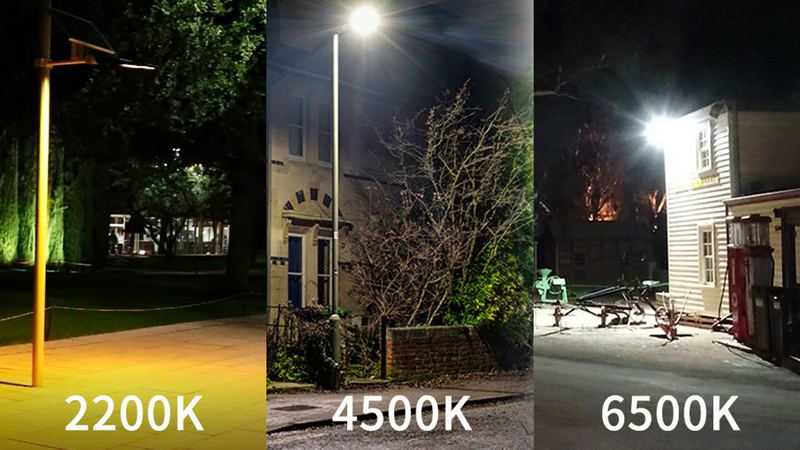
Different CCT Of LED Street Lighting
Color Rendering Index (CRI) for LED Street Lights is largely depending on the particular light in the issue. Despite this, a wide range of CRI values, typically between 65 and 95, are available.
Low Pressure Sodium (LPS) Lights are well known for having the lowest CRI ratings available. They often score around 25 out of 100, with 100 being the highest possible score. The monochromatic yellow light that LPS lamps create significantly reduces the ability to see color at night.
High Pressure Sodium (HPS) lights (HPS lights emit a yellow to white light) have slightly better color rendering than other types of lamps, but it is still quite poor.
WINNER: LED STREET LIGHTS
Due to their quick response times, LED Street Lights are the perfect illumination for purposeful on/off switching (there is no warm up or cool down period). They generate constant, flicker-free light.
As High Pressure Sodium Lights near the end of its useful life, it may flicker or alternately turn on and off. Low Pressure Sodium Lights simply fail to strike (switch on) or remain in the warm-up phase, which is indicated by a weak reddish to pink glow, rather than cycling as they approach the end of their useful lives.
Because they must be lit before they reach steady state, both LPS and HPS lights display a brief delay while turning on. Cycling may occur even if the starting is generally functioning well due to the lamp's constant attempts to ignite itself. This can happen if there are issues with the starter or if a starter and an HPS lamp are not properly matched.
WINNER: LED STREET LIGHTS
LED Street Lights are fairly simple to dim, and there are options to use anywhere from 100% to 0% of the light. Lowering the forward current or varying the pulse duration is how LED dimming works.
HPS & LPS Lights can be manually muted by using various electric or magnetic ballasts, although doing so can modify the voltage input to the light and hence affect its properties. Dimming can occasionally cause a light to go off too soon (especially with older HID bulbs). For High Pressure Sodium bulbs, continuous dimming typically reduces the light output from 100% to 30%.
WINNER: LED STREET LIGHTS
LEDs in LED Street Lights produce 180 degrees of light. Since light is frequently needed over a target region, this is usually advantageous (rather than all 360 degrees around the bulb). Learn more about the concept of "useful lumens" or "system efficiency" to get a better understanding of the effects of directed lighting.
Light is emitted omnidirectionally by all high intensity discharge lamps, including HPS and LPS as examples. This indicates that they release light in all directions, necessitating the use of reflectors or fixture housings to focus a major amount of the emissions into the intended target region.
WINNER: LED STREET LIGHTS
Compared to all other types of lights on the market, the luminous efficacy of LED Street Lights are incredibly high. A typical source's lumens per watt falls between 37 and 120. However, the system efficiency of LEDs is where they truly shine (the amount of light that actually reaches the target area after all losses are accounted for). The majority of LED system efficiency figures are higher than 50 lumens/watt.
Only Low and High Pressure Sodium lamps (LPS and HPS, respectively, have values ranging between 50 and 160 lumens/watt) and slightly less efficient alternatives to LEDs are available. They frequently fall short of LEDs because of losses connected with omnidirectional light production and the requirement to direct it to a particular location, which results in a system efficiency that is frequently substantially lower.
WINNER: LED STREET LIGHTS
As current rises, LED efficiency decreases, the luminous efficacy of LED Street Lights also decrease. Additional current also results in an increase in heat output, which shortens the device's lifespan. With an average production of about 80% near the end of life, the total performance decline is relatively mild over time.
Halfway through their lifespan, High Pressure Sodium lamps still have 90% of their original brightness (around 12,000 hours). At the end of their useful lives, HPS bulbs typically emit 80% of their original rated power (around 24,000 hours).
WINNER: LED STREET LIGHTS
In contrast to conventional lighting, LEDs in LED Street Lamps produce a relatively narrow spectrum of visible light, meaning that most of the energy used by the light source is transferred directly to visible light without any losses to heat or other radiation types (IR, UV).
A fairly limited spectrum of light is produced by LPS and HPS Lamps (particularly LPS lights). LPS lights are so advantageous since they reduce electromagnetic interference in close proximity to facilities used for astronomical observation.
WINNER: LED STREET LIGHTS
The most common cause of failure of LED street lights is the drivers. The failure rate of LEDs is relatively low. There are generally a lot of LED chips in each LED lamps. With the maturity of LED lamp technology, generally the damage of one or two LED chips will not affect the lighting effect of LED lamp.
High and Low Pressure Sodium lights can malfunction in a variety of ways. In most cases, they display an end-of-life phenomenon called cycling when the lamp turns on and off on its own before eventually failing completely.
WINNER: LED STREET LIGHTS
Very little forward heat is produced by LED Street Lights. It means that the energy in LED lighting is effectively consumed, few ineffective consumption and energy waste.
LPS and HPS emit more heat than LED lights, which is either absorbed by the ballast or lost to the environment.Due to energy loss and heat losses, about 15% of the emissions are lost. Although heat emissions may be advantageous under some conditions, they are generally undesirable since they signify energy inefficiency. The device's main objective is to emit light, not heat.
WINNER: LED STREET LIGHTS
LED Lights have a longer lifetime than any other traditional lights available in the market. Although lifespans can vary, common values fall between 25,000 and 200,000 hours or more before a lamp or fixture needs to be replaced.
In areas where energy saving is a priority, high pressure sodium lamps have historically been utilized for outdoor street lighting because of their outstanding longevity (albeit not as good as LED). An HPS bulb has a typical lifespan of about 24,000 hours. At the halfway point of their lifespan, HPS lamps continue to provide 90% of their initial light output, according to American Electric Lighting. Near roughly 80%, lumen maintenance is still excellent at the end of its life. LPS lights have a marginally lower lifetime (typically failing around 18,000 hours of operation).
WINNER: LED STREET LIGHTS
The initial investment of LED street lighting solutions is relatively high. While LED street lighting has a low lifetime costs. Over time, the technology pays back the investor (the payback period). Reductions in maintenance costs over time (depending on labor costs) and subsequently increased energy efficiency provide the biggest paybacks (dependent on electricity costs).
Low and high pressure sodium lamps are extremely affordable to buy and maintain. However, even though LPS and HPS bulbs have a longer lifespan than the majority of their rivals, they are still inferior to LEDs. To achieve the same lifespan as a single LED light, LPS or HPS bulbs will still probably need to be bought multiple times and the accompanying labor costs will need to be paid.
WINNER: LED STREET LIGHTS
LED street lights almost have zero maintenance costs because LED lights do not need to replace lamps or replace bulbs frequently like other lamps.
Within the lifespan of a single LED, Low and High Pressure Sodium bulbs will still need to be replaced numerous times in addition to the labor costs to monitor and repair aging or expired components.
WINNER: LED STREET LIGHTS
The cost of LED street lights are a bit high, but it still varies depending on its design, functions andspecifications. For example, the typical 100W-equivalent LED street lights prices usually range from $20 to $40.
The price of low and high pressure sodium lights varies based on the type of light. In comparison to LEDs, they are typically less expensive ($5–$10 for a 100W equivalent LPS or HPS bulb).
WINNER: LPS & HPS Lights
LEDs, as solid state lights, are difficult to damage during shocks. Now the LED chips are firmly fixed on the PCB board of the LED street lights by SMD. ZGSM Rifle series LED street lamps have passed the shock resistance test, no problem to be applied in the lighting of roads, bridges and railways.
Compared to LEDs, low and high pressure sodium bulbs are more fragile. This is especially true of linear tube-mounted bulbs. HPS and LPS lights use a glass bulb, like the majority of traditional lamps.
WINNER: LED STREET LIGHTS
LEDs could work normally at minus 40 degrees to 100 degrees in both indoor and outdoor lightings. They do, however, exhibit diminished performance at appreciably high temperatures, and they necessitate extensive heat dissipation, particularly when placed near other delicate components. Pls notice the temperatures above don't refer to ambient temperature. LED street lights manufactured by ZGSM have an excellent heat dissipation performance, and could work under the ambient temperature of minus 40 degrees to 50 degrees, no problem to work in areas with hot weather, such as Africa, South America, the Middle East, and so on.
Low and High Pressure Sodium Lights could also work at minus 40 degrees. However, no unbiased information about fluorescent bulb performance in high-temperature environments was found by us. Pls kindly contact us if you have any information.
WINNER: LED STREET LIGHTS
LED Road Lights have almost no warm-up time, and reaches their maximum brightness as soon as turned on.
LPS & HPS Lights do really need a period of warm up. The time differs depending on different types and designs of lights. The LPS or HPS lamp may take up to 10 minutes to reach its typical working temperature and brightness.
WINNER: LED STREET LIGHTS
Due to the long service life of LED Street lamps, the warranty of LED street lights is generally longer. Take ZGSM as an example, we provide 3-10 years warranty for the LED lighting fixtures produced by our company.
The typically warranty of Low Pressure Sodium and High Pressure Sodium lights is about 1-3 years.
WINNER: LED STREET LIGHTS
After reading the above, it is not difficult to understand why LED street lights push the sodium vapor lamps out of the market. Now the world is undergoing a lighting revolution, and more and more sodium vapor lamps are or will be replaced by LED lights. They fall well short of LEDs in the majority of areas (like lifespan, for example). The only advantage of LPS & HPS lamps is that the price is cheaper and the initial investment is lower. While over the long term, LED lights really provide significant economic advantages due to their incredibly cheap maintenance and replacement prices. LED lights life expectancy can exceed 100,000 hours (more than four times that of LPS or HPS). One of the main benefits of LEDs is that you just need to buy one lamp instead of three or four sodium vapor bulbs over time. The fact remains that, given the availability of LED lighting, sodium vapor lights no longer have their historical advantage of being the most energy-efficient bulb on the market.
There is no need to worry about blue lights emitted by LED street lighting disrupting sleep. The blue light from LEDs is identical to that from other light sources, according to the US Department of Energy. The intensity of light at night is more crucial. The amount of light, the timing, and the duration of light exposure all have a role in the disruptive effect. LED street lighting produces light levels that are too low to alter hormone levels that regulate our sleep habit, according to research.
In comparison to traditional street lights, which typically include a reflector on the rear side of a high-pressure sodium lamp, most LED street lights have a lens on the LED panel that is designed to cast its light in a rectangular pattern.
Color temperature is expressed in Kelvin and is a mathematical calculation based on a light source's Spectral Power Distribution (SPD). It enables a large range of unique color combinations. Different combinations of Correlated Color Temperature (CCT) and Color Rendering Indexes (CRI) are available in LED lighting, which can have different impacts on eyesight. The color temperature is measured in degrees Kelvin, with a warm light (yellowish) being around 2700K, neutral white being approximately 4000K, and cool white (bluish) being around 5000K or more.
Protecting the public with lighting that promotes alert drivers and a safe environment may be the greatest priority in many outdoor applications, to explain why it's necessary. In those circumstances, the suggested color temperature is used, taking into account the space and the people who will be using it.
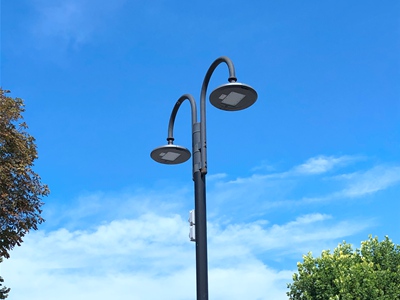 | 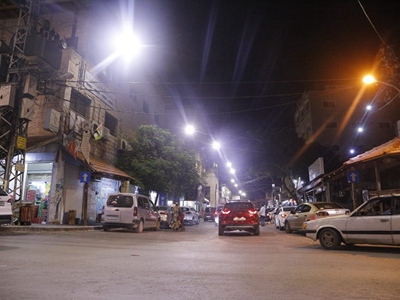 | |
| Points About Purchasing LED Street Lights | ||
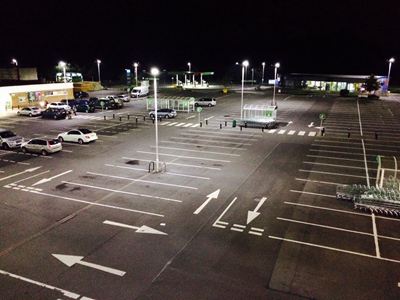 | 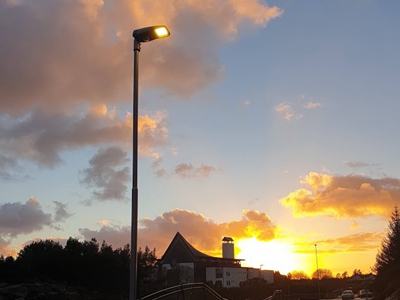 | |
| Correct Installation And Use Of LED Street Lights | LED Street Light System Installation Process | Will LED Street Lights Pollute The Environment? |
Share the Post
Related Posts
Add: 1-1 Dabai Road, Lin’an District, Hangzhou, 311300 Zhejiang, China.
Copyright © Hangzhou ZGSM Technology Co., Ltd. All Rights Reserved
